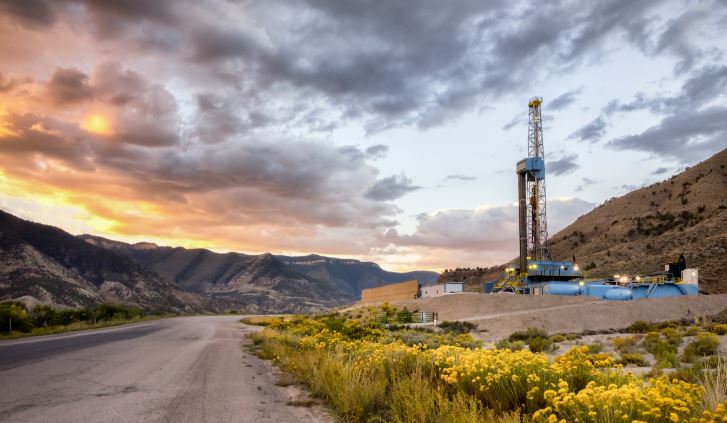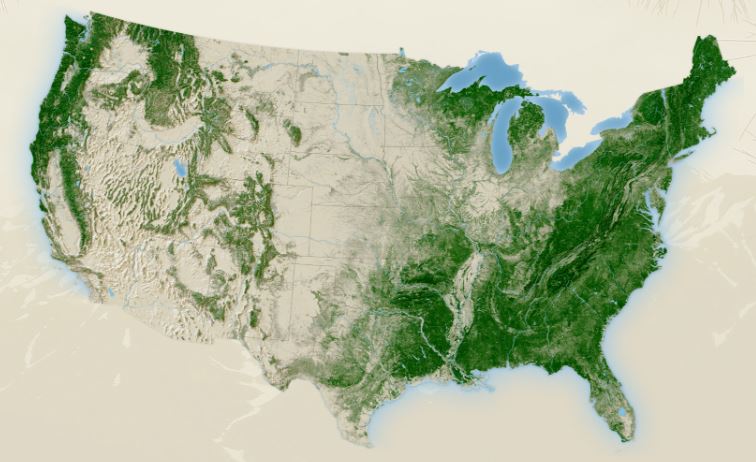Allowing states to regulate the energy resources on federal lands means more efficient and accountable management. States share the cost of the maintenance of federal lands and have regulatory structures to manage federal lands within their boundaries.
Excerpts from Daily Signal
The Federal Land Freedom Act: Empowering States to Regulate Energy Will Yield Better Economic and Environmental Results
The United States remains the leading producer in petroleum and natural gas hydrocarbons, which has produced astounding economic benefits and put money back into the wallets of American families.[1]The story is made more amazing by the fact that federal energy policy actively hindered this energy renaissance as it was taking place. Centuries’ worth of oil, natural gas, and coal resources lie beneath private property as well as under lands owned by state governments. While federally owned lands are also full of energy potential, a bureaucratic regulatory regime has mismanaged land use for decades. The tremendous economic benefits of open energy markets and the proven track record of the individual states’ regulatory structures dictate a re-examination of the way the federal government manages resources on federal lands.
The Federal Land Freedom Act gives states the authority to administer leasing, permitting, and regulatory programs for development of all energy resources on federal lands. States are already well positioned to help make a transition to better management of these resources. While Congress should pursue opportunities to reduce the size of the federal estate through privatization and transferring land to states and counties, the Federal Land Freedom Act is a significant step toward better management of America’s lands and natural resources.
Key points include:
- The sheer size and diversity of the federal estate and its resources are too much for distant federal bureaucracies and an overextended federal budget to manage effectively. The government’s ill-suited management of federal land fails to fully take into account competing local interests through cumbersome federal and congressional channels.
- Allowing states to regulate the energy resources on federal lands means more efficient and accountable management. States share the cost of the maintenance of federal lands and have regulatory structures to manage federal lands within their boundaries.
- The United States has an abundance of natural resources. Lifting restrictions on energy production that are devoid of any meaningful environmental benefit will add 700,000 jobs and $3.7 trillion in gross domestic product through 2035. Electricity expenditures for households will decline by up to 10.19 percent per year. For a family of four, this means an additional $40,000 of income by 2035.
The Federal Land Freedom Act
The Federal Land Freedom Act would allow states to develop energy resources on federal land that is not Indian land, part of the National Park System, the National Wildlife Refuge System, or a congressionally designated area. The legislation would allow states to develop programs that satisfy all applicable federal laws required to produce energy on federal lands. Therefore, states would have complete control of their energy programs. Further, states would submit a declaration of their program to the Departments of Agriculture, Energy, and Interior, and the program would not be subject to judicial review.
This would be sufficient in lieu of redundant federal requirements, such as the National Environmental Policy Act. While very few benefit from stagnant production on federal land, many would benefit from the new management that the Federal Land Freedom Act recommends.
Inefficient Federal Management Hurts the Economy and Environment
The federal estate is massive, consisting of some 635 million to 640 million acres and hundreds of millions of subsurface mineral rights below the surface and offshore. According to the Department of Interior’s Bureau of Land Management (BLM), “These surface lands are located primarily in the West, but the bureau has a national presence with responsibilities for some 700 million acres of sub-surface mineral estate underlying both Federal and non-Federal lands.”[2]
The effective footprint is perhaps even larger as limitations on federal lands often impact the use of adjacent state and private lands, and as government agencies lock up lands through informal designations and study areas. Federal ownership of land results in a one-size-fits-all approach to land management. It also disincentivizes production on non-federal lands located adjacent to or interspersed with federal lands: Production on federal lands is much more difficult, so drilling may make economic sense only if a company has access to both the federal land and the non-federal land. At the very least, the proximity of federal lands makes the non-federal lands less attractive.
America’s largest land holder, the Department of the Interior, has a maintenance backlog of $13.5 billion to $20 billion for the land it already owns—a deficit leading to environmental degradation, soil erosion, gross amounts of littering, and land mismanagement.[3] The sheer size and diversity of the federal estate and the resources both above and below ground are too much for distant federal bureaucracies and an overextended federal budget to manage effectively. Energy production on federal land, or the lack thereof, and the painstakingly long and duplicative regulatory process is an illustrative example. For instance, the BLM announced in 2011 that it was nearing completion of a two-year backlog of oil and gas leases in Wyoming, tying up more than $50 million in lease sales.[4] In 1988, the BLM, which oversees 248 million acres of federal land and 700 million acres of underground mineral resources, leased 12.2 million acres; only one-tenth of that was made available in 2014.[5]
Conversely, paperwork and regulatory hoops seem to have increased. The BLM estimates that it took an average of 227 days simply to complete a drill application—just one step in the approval process to harvest oil and gas resources on federal lands. This is compared to 154 days in 2005.[6]It should hardly be assumed that the time spent on arduous paperwork improves environmental protection.
Reaching America’s True Energy Potential
In March 2012 President Barack Obama stated, “We can’t just drill our way to lower gas prices.”[37] He said the same thing earlier that year on the campaign trail.[38] He said it a lot.[39]Perhaps the line polled well, but it was not true. The U.S. did drill its way to lower gas prices over the past several years (for both natural gas and gasoline) and broke the back of the Organization of Petroleum Exporting Countries (OPEC) in the process.[40]
The doubling of U.S. oil production between 2008 and 2015 is an amazing story of American ingenuity, persistence and, of course, drilling. The story is made more amazing by the fact that federal energy policy actively hindered this energy renaissance as it was taking place. In the first few months of the Obama Administration, the Department of the Interior cancelled oil and gas lease sales.[41] In 2011, the Obama Department of the Interior blocked access to most of America’s offshore oil and gas reserves, placing a de facto moratorium on drilling.[42] The Environmental Protection Agency’s (EPA’s) hostility to the oil and gas industry was exemplified by regional administrator and Obama appointee Al Armendariz, who was captured on tape explaining that his policy was to “crucify” select oil and gas firms in order to terrify the others.[43]
In spite of the Administration’s policies, the energy sector thrived because of production on private and state-owned lands. As the U.S. drilled its way to low petroleum prices, oil production from the federal estate was stagnant or declining.[44] So, it is reasonable to ask: What sort of energy powerhouse could the U.S. be with an energy policy that unleashes America’s total energy potential?
In its Annual Energy Outlook, the federal government’s Energy Information Administration (EIA) makes projections of energy production, consumption, and prices. The reference case assumes midpoint projections for energy resources and assumes that regulations follow their legislative timelines. As part of its sensitivity analysis, the EIA also produces two side cases where energy resources are assumed to be (a) 50 percent higher and (b) 50 percent lower than the reference case. Though these side cases are not intended to model policy changes, the High Resource Case offers a glimpse of what might be.
It should be noted that a 50 percent increase in resource availability is not a pie-in-the-sky fantasy. U.S. petroleum production in 2015 was about 50 percent higher than the projection the EIA made for 2015 in 2008.[45] Natural gas production in 2015 was about 40 percent higher than the EIA’s 2008 projection. The comparative pessimism on the part of the EIA was largely due to not fully appreciating the impacts of smart drilling technology and hydraulic fracturing (fracking) at that time.
Without comprehensive seismic mapping and exploration, an accurate estimate of the recoverable natural resources that are currently locked up on federal lands and the continental shelf is unlikely. However, the combination of a rational regulatory environment such as devolving responsibility to the states combined with open access would likely put a 50 percent increase within reach.
Using a clone of the EIA’s National Energy Modeling system, Heritage Foundation analysts looked at the impact of the High Resource Case on income and employment, as well as the impact on energy markets. The results are intriguing.
Heritage analysis shows that lifting needless restrictions on energy production that produce little, if any, environmental benefit will increase employment by an average of 700,000 jobs through 2035. Along with the jobs comes $2 trillion in additional economic growth that translates to an additional $40,000 of income per family of four by 2035. These economic gains arise for a variety of reasons. First, there is an increase in job creation directly associated with producing shale oil and gas not otherwise under current policy. There are often tremendous job opportunities for engineers, geologists, mathematicians, truck drivers, welders, and others as well.
In addition, the resulting energy—used all across the economy—becomes less expensive. Cheaper energy lowers the cost of doing business, making American companies more competitive and enabling them to invest and expand. There are also increased needs for associated manufacturing as well as demand for repair shops, menders, hardware stores, restaurants, hotels, and laundromats among many others. Natural gas and butane, ethane, and propane removed from natural gas provide feedstock for fertilizers, chemicals, and pharmaceuticals. The shale gas boom resulted in more than $100 billion in new chemical manufacturing investment.[46]
Nicholas Loris
 Free Range Report
Free Range Report








